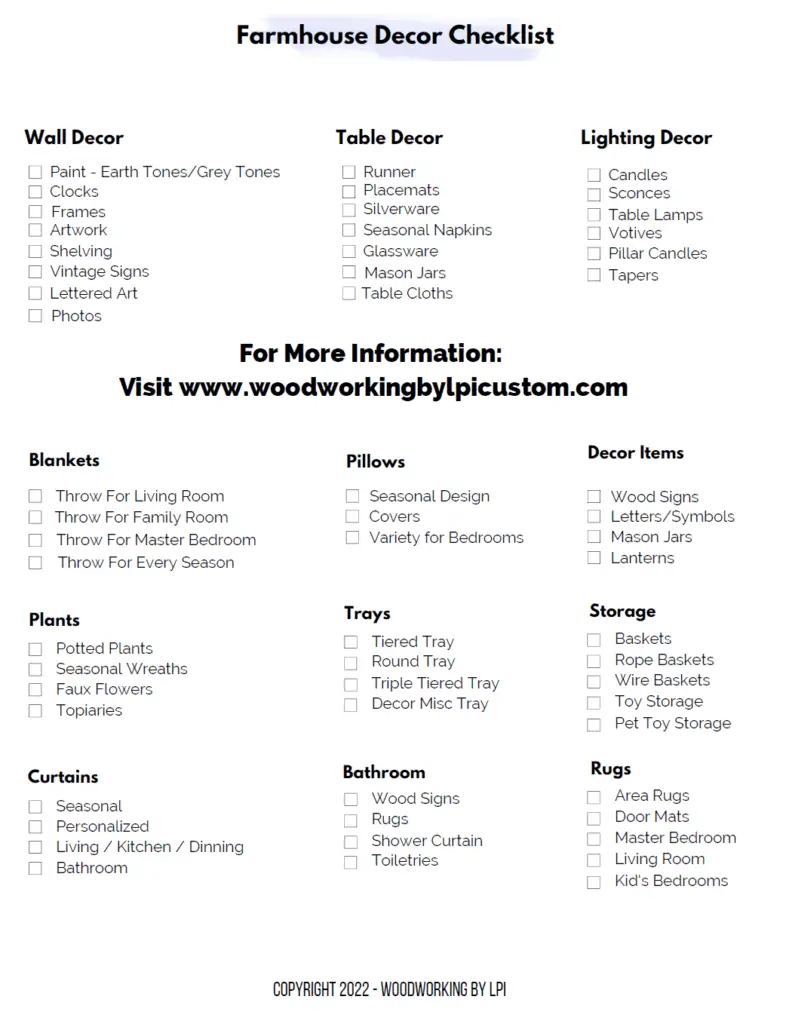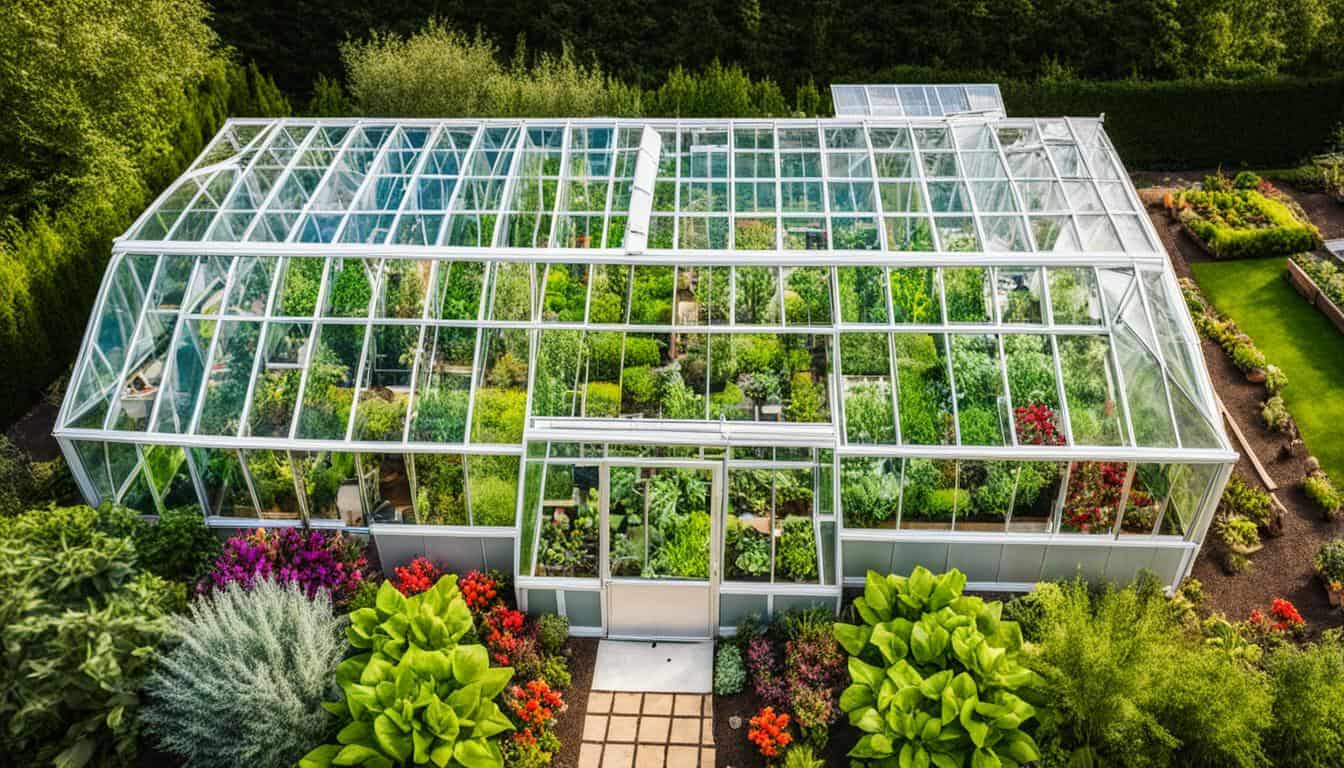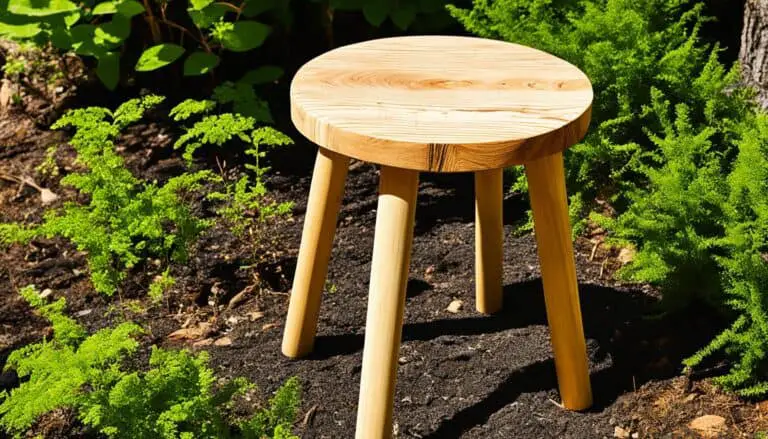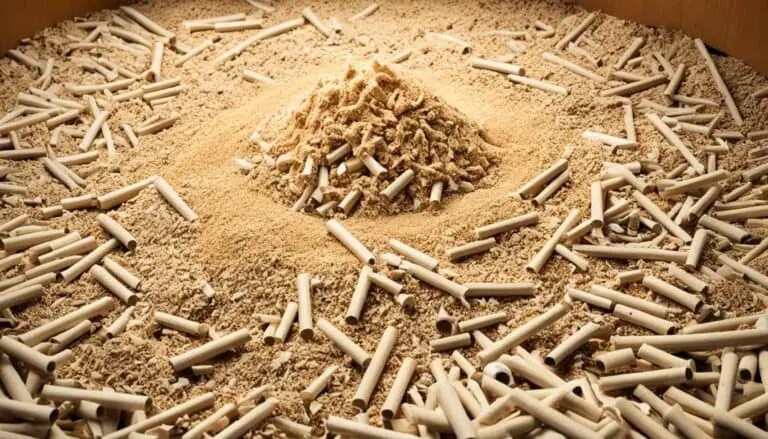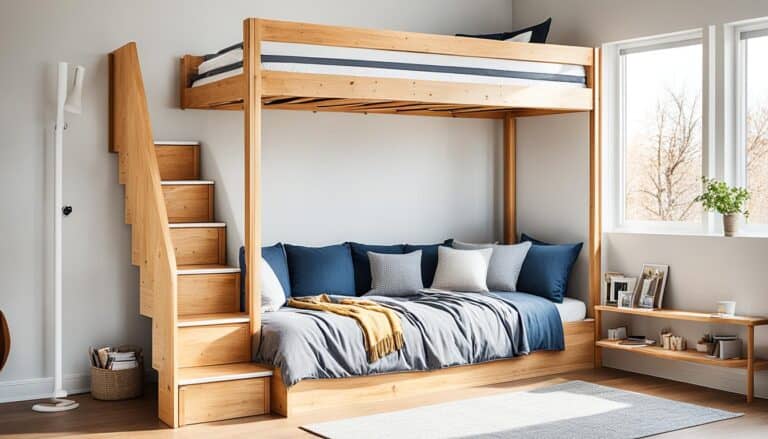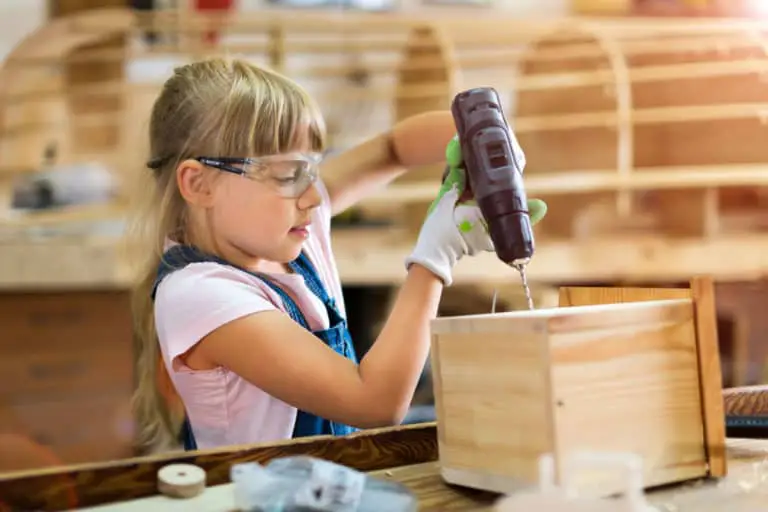Are you a passionate gardener looking to take your gardening game to the next level? Have you ever considered building your own greenhouse? Whether you have a small backyard or a spacious garden, sustainable greenhouse plans can be the key to creating a thriving and eco-friendly growing space. But where do you start? How do you design and build a greenhouse that meets your needs and supports sustainable gardening practices?
In this article, we will guide you through the process of designing and building a sustainable greenhouse that suits your unique gardening requirements. From DIY greenhouse plans to creative design ideas, we will provide you with the knowledge and inspiration to create an environmentally friendly greenhouse that maximizes plant growth and minimizes your ecological footprint.
Get ready to unlock the secrets of sustainable greenhouse plans and embark on a journey to greener, more abundant gardens. Let’s dive in!
Key Takeaways:
- Discover the benefits of sustainable greenhouse plans for every gardener.
- Explore various types of greenhouse designs and find inspiration for your own project.
- Learn essential considerations for designing an eco-friendly greenhouse.
- Find out how to select the right size and location for your greenhouse.
- Explore eco-conscious materials and innovative DIY greenhouse ideas.
Embracing Year-Round Gardening with Sustainable Greenhouses
When it comes to gardening, nothing is more rewarding than being able to enjoy the beauty and freshness of your plants year-round. With sustainable greenhouses, you can make this dream a reality. These structures provide a controlled environment that allows you to cultivate plants regardless of the outside weather conditions.
The Dream of a Four-Season Growing Space
Imagine having a garden that flourishes in every season, where you can grow your favorite flowers, herbs, and vegetables no matter the time of year. With a sustainable greenhouse, you can create a four-season growing space that extends beyond the limits of traditional outdoor gardening. This means that you have the freedom to grow plants that would otherwise not survive in your local climate.
Whether you live in a region with harsh winters or scorching summers, a greenhouse provides a sheltered environment where you have full control over temperature, humidity, and light. This allows you to grow plants that would typically only thrive in specific seasons, opening up a whole new world of gardening possibilities.
Benefits of Sustainability in Greenhouse Gardening
Aside from the ability to grow plants year-round, sustainable greenhouses offer numerous other benefits for gardeners. Let’s take a look at a few key advantages:
- Extended Growing Seasons: With a greenhouse, you can start planting earlier in the spring and continue growing later into the fall, giving you even more time to enjoy your garden.
- Protection from Extreme Weather Conditions: Greenhouses shield your plants from harsh weather elements such as frost, strong winds, heavy rain, and excessive heat, ensuring their safety and well-being.
- Reduced Reliance on External Resources: By creating a self-sustaining ecosystem within your greenhouse, you can reduce your reliance on external resources like water and synthetic fertilizers. By using techniques such as composting and harnessing natural sunlight, you can create a more eco-friendly and sustainable garden.
Overall, sustainable greenhouses offer a multitude of benefits that go beyond just year-round gardening. They provide a unique opportunity to create a thriving and environmentally conscious garden space where you can cultivate plants of your choosing, no matter the season or weather conditions.
Take a look at the image below to catch a glimpse of the beauty and potential that sustainable greenhouses hold:
Now that we’ve explored the concept of year-round gardening and the benefits of sustainable greenhouses, let’s dive deeper into the considerations for designing an eco-friendly greenhouse in section 3.
Considerations for Designing Your Eco-Friendly Greenhouse
When designing your eco-friendly greenhouse, there are several important considerations to keep in mind. By incorporating sustainable design principles, you can create a greenhouse that is not only environmentally friendly but also promotes optimal plant growth. Here are some key factors to consider:
- Location: Choose a location that receives ample sunlight throughout the day. This will maximize natural light exposure for your plants and reduce the need for artificial lighting. Additionally, consider the proximity to a water source for easy irrigation.
- Orientation: Orient your greenhouse in a way that takes advantage of seasonal changes in sunlight. This may involve angling the structure to capture the most sunlight during winter months and provide shade during summer months.
- Ventilation: Adequate ventilation is crucial for regulating temperature and humidity levels inside the greenhouse. Incorporate windows, vents, or fans to promote air circulation and prevent the buildup of heat and condensation.
- Energy Efficiency: Implement energy-efficient features in your greenhouse design to minimize energy consumption. This can include installing insulated glazing, using energy-efficient lighting systems, and integrating renewable energy sources such as solar panels.
By considering these design aspects, you can create an eco-friendly greenhouse that provides an optimal growing environment for your plants while minimizing its impact on the environment. The image above showcases a beautiful example of an eco-friendly greenhouse design.
Greenhouse Plans: Selecting the Right Size and Location
When it comes to designing a sustainable greenhouse, selecting the right size and location are crucial factors to consider. The size of your greenhouse will determine the amount of space available for your plants to grow and flourish. Additionally, the location of your greenhouse plays a vital role in ensuring optimal sunlight exposure and protection from the elements.
Criteria for a Successful Sustainable Greenhouse
Creating a successful sustainable greenhouse requires careful consideration of several criteria. Here are some key factors to keep in mind:
- Size: Determine the size of your greenhouse based on the available space and the number of plants you intend to grow. Consider both the current and future needs of your garden.
- Orientation: Position your greenhouse in a way that maximizes sunlight exposure and minimizes shading from nearby structures or trees.
- Ventilation: Ensure proper airflow within the greenhouse to regulate temperature, prevent condensation, and reduce the risk of disease.
- Insulation: Choose materials that provide adequate insulation to maintain a stable and comfortable environment for your plants.
- Energy Efficiency: Opt for energy-efficient features and systems to reduce energy consumption and minimize environmental impact.
- Sustainability: Emphasize the use of eco-friendly materials and practices throughout the construction and operation of your greenhouse.
Location, Sunlight, and Protecting from the Elements
When selecting the location for your greenhouse, there are a few key considerations to take into account:
- Sunlight Exposure: Choose a location that receives ample sunlight throughout the day. This will provide the necessary light for photosynthesis and ensure healthy plant growth.
- Shading: Assess the area surrounding your greenhouse to identify any potential sources of shade, such as neighboring buildings or trees. Minimize shading to optimize sunlight penetration.
- Protection from Elements: Consider the prevailing weather conditions in your area, including wind patterns and exposure to harsh elements. Position your greenhouse in a way that provides protection against strong winds, heavy rain, or extreme temperatures.
By carefully selecting the right size and location for your greenhouse, and taking into account the criteria for sustainability and the specific needs of your plants, you can create an ideal environment for your garden to thrive.
Structural Materials: Making Eco-Conscious Choices
When it comes to sustainable greenhouse construction, choosing the right structural materials is essential. Not only do eco-conscious materials contribute to a greener environment, but they also offer long-term benefits for your greenhouse. By opting for green building materials, you can create a sustainable and eco-friendly space that aligns with your commitment to environmental stewardship.
There are several options available for those looking to make eco-conscious choices for their greenhouse construction. Here are some examples of environmentally friendly materials:
- Recycled Materials: Utilizing recycled materials such as reclaimed wood and recycled plastic can help reduce the demand for new resources. Not only do these materials minimize waste, but they also provide strength and durability.
- FSC-Certified Wood: Choosing wood that is certified by the Forest Stewardship Council (FSC) ensures that it comes from responsibly managed forests. FSC-certified wood is harvested in a sustainable manner, making it an eco-friendly choice for greenhouse construction.
- Energy-Efficient Glazing: Opting for energy-efficient glazing materials can enhance the insulation properties of your greenhouse. Double or triple-pane glass, polycarbonate sheets, or insulated panels can help regulate temperature and reduce heat loss, resulting in energy savings.
By selecting these eco-conscious materials, you can create a greenhouse that embodies sustainable practices while providing a conducive environment for your plants. Incorporating environmentally friendly construction materials not only benefits the planet but also contributes to the long-term success of your greenhouse.
Innovative DIY Greenhouse Plans and Ideas
In this section, we will showcase innovative DIY greenhouse plans and ideas. Whether you are a seasoned gardener or just starting out, building your own greenhouse can be a rewarding and cost-effective way to extend your growing season and protect your plants. With a wide range of options available, you can choose from upcycled materials to create a sustainable and eco-friendly greenhouse or explore unique designs such as geodesic domes for a visually striking structure. Additionally, custom greenhouse building allows you to tailor the design to suit your specific needs and preferences, ensuring that your greenhouse functions optimally for your gardening goals.
One of the exciting aspects of DIY greenhouse plans is the possibility of using upcycled materials. By repurposing old windows, doors, or even plastic bottles, you can create a greenhouse with minimal environmental impact, reducing waste and avoiding the need for new materials. Not only is this a sustainable choice, but it can also add a unique and charming aesthetic to your greenhouse.
If you’re looking for a more unconventional design, geodesic greenhouses offer a visually stunning option. Geodesic domes are constructed from interconnected triangles, providing excellent structural strength and stability. These domes distribute weight evenly and allow for maximum sunlight penetration, creating an ideal environment for your plants. Geodesic greenhouses are not only practical but also make a striking centerpiece in any garden.
Custom greenhouse building allows you to design a greenhouse that suits your specific gardening needs. Whether you have limited space or specific plants that require unique growing conditions, a custom greenhouse can be tailored to accommodate these requirements. From incorporating additional shelving and storage to creating separate climate zones within the greenhouse, a custom design ensures that your greenhouse functions in the most efficient and effective way possible.
With the abundance of innovative DIY greenhouse plans and ideas available, there is a solution for every gardener’s needs. By embracing upcycled materials, exploring geodesic designs, or opting for custom greenhouse building, you can create a sustainable and functional space for your plants to thrive. Get creative and let your imagination run wild – the possibilities are endless!
Insulation Techniques for Year-Round Warmth
Insulating your greenhouse is essential for maintaining year-round warmth, allowing you to provide the optimal environment for your plants. In this section, we will explore various insulation techniques that can help regulate temperature and improve energy efficiency in your greenhouse.
Choosing Eco-friendly Insulation Materials
When selecting insulation materials for your greenhouse, it’s important to prioritize eco-friendly options that minimize environmental impact. Here are some sustainable insulation materials to consider:
- Recycled Insulation: Materials such as recycled paper, denim, or cellulose insulation can provide effective thermal insulation while reducing waste.
- Natural Insulation: Natural options like sheep’s wool, cork, or hemp insulation offer excellent thermal properties and are renewable and biodegradable.
- Reflective Insulation: Reflective materials, like aluminum foil, can help conserve heat by reflecting it back into the greenhouse. Opt for recycled or recyclable options.
By choosing eco-friendly insulation materials, you can create a sustainable greenhouse that aligns with your environmental values.
Low-Cost Insulation Hacks for the Greenhouse
If you’re on a tight budget, there are several low-cost insulation hacks that can help improve the energy efficiency of your greenhouse:
- Bubble Wrap: Covering your greenhouse windows with bubble wrap can create an insulating air pocket that helps retain heat.
- Straw Bale Walls: Building walls with straw bales can provide thermal insulation and help regulate temperature fluctuations.
- Thermal Curtains: Hanging thermal curtains or blankets around the perimeter of your greenhouse can create an additional barrier against cold drafts.
These low-cost insulation hacks can be effective in improving the insulation properties of your greenhouse without breaking the bank.
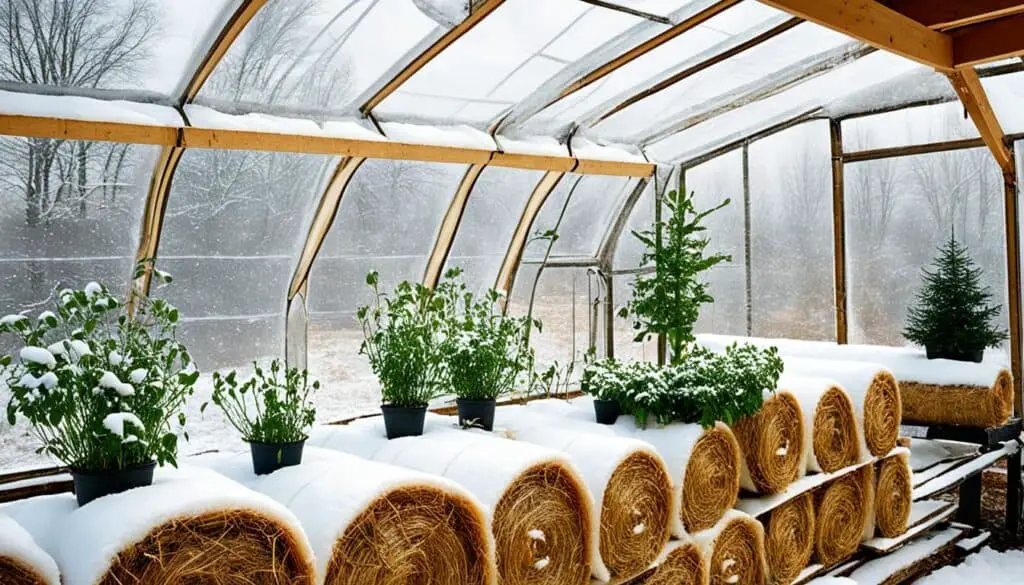
Implementing insulation techniques and using eco-friendly materials can help you maintain year-round warmth in your greenhouse while minimizing environmental impact. By carefully selecting insulation materials and considering low-cost insulation hacks, you can create a sustainable and energy-efficient greenhouse that provides the ideal growing environment for your plants.
Heating Strategies: Balancing Temperature Sustainably
In order to maintain a sustainable temperature inside your greenhouse, it is crucial to implement effective heating strategies. By utilizing energy-efficient heating options and adopting heat retention techniques, you can reduce your reliance on traditional heating sources and minimize energy consumption.
One of the most cost-effective and eco-friendly heating options is solar heating. By harnessing the power of the sun, you can heat your greenhouse during the day without relying on electricity or fuel. Installing solar panels or utilizing solar air heaters are effective ways to take advantage of this renewable energy source.
Biomass heating is another sustainable option that utilizes organic materials such as wood pellets, agricultural waste, or sawdust to generate heat. These materials are renewable and have a lower carbon footprint compared to fossil fuels. Biomass heating systems can be integrated into the greenhouse’s heating infrastructure for optimal temperature regulation.
Additionally, implementing heat retention techniques will help preserve warmth inside the greenhouse. One effective method is to insulate the greenhouse using materials with high thermal resistance, such as polycarbonate or double-glazed glass. This will prevent heat loss and maintain a consistent temperature even during colder periods.
An alternative heat retention technique is the use of thermal mass materials, such as water-filled barrels or stone walls. These materials absorb and store heat during the day, gradually releasing it during colder periods, thus regulating the temperature inside the greenhouse.
By employing a combination of energy-efficient heating options and heat retention techniques, you can achieve sustainable temperature regulation in your greenhouse. This not only reduces your environmental impact but also helps create a more cost-effective and energy-efficient growing environment for your plants.
Advanced Glazing Options for Efficiency and Durability
In order to ensure the efficiency and durability of your greenhouse, it is crucial to carefully consider the glazing options. The choice of glazing material has a significant impact on both light transmission and insulation properties, ultimately affecting the overall performance of your greenhouse.
Comparison of Glazing Materials for Optimized Light Transmission
When selecting glazing materials for your greenhouse, it is important to prioritize light transmission. Different materials have varying levels of light transmittance, which can greatly impact plant growth. Here are some common glazing options to consider:
- Glass: Glass is a traditional and widely-used glazing material known for its excellent light transmission properties. It allows for maximum sunlight exposure, promoting optimal plant growth. However, glass can be heavy and brittle, making it less suitable for areas prone to strong winds or impacts.
- Polycarbonate: Polycarbonate is a lightweight and shatter-resistant glazing material that offers excellent light transmission. It is highly durable and can withstand harsh weather conditions. Polycarbonate sheets are available in various thicknesses, with thicker sheets offering improved insulation.
- Fiberglass: Fiberglass, also known as FRP (Fiber Reinforced Plastic), is a lightweight and durable glazing option. It provides good light transmission and is resistant to impact and UV radiation. Fiberglass is available in different colors, allowing for customized light diffusion.
Each of these glazing materials has its own advantages and considerations. It is important to evaluate your specific needs, local climate, and greenhouse design before selecting the most suitable option.
Understanding R-values and Their Importance
In addition to light transmission, the thermal insulation properties of a glazing material are essential for maintaining a stable and energy-efficient greenhouse environment. The R-value is a measure of a material’s resistance to heat transfer, with higher R-values indicating better insulation capabilities.
R-values in greenhouse glazing materials play a crucial role in minimizing heat loss during colder months and preventing excessive heat gain in warmer climates. By choosing glazing materials with higher R-values, you can create a more energy-efficient greenhouse and reduce your reliance on supplemental heating or cooling.
When comparing glazing materials, it is important to consider their respective R-values and how they align with your local climate and greenhouse heating and cooling needs.
Water Management: Smart Irrigation and Collection
In order to ensure efficient water usage in your greenhouse, implementing smart irrigation systems is crucial. One popular method is drip irrigation, which provides precise water distribution directly to the plant roots. This not only reduces water waste but also minimizes the risk of disease by avoiding wet foliage.
Drip irrigation involves the use of small tubing or pipes with emitters that release water slowly and steadily. The system can be automated and controlled, allowing you to customize watering schedules and ensure each plant receives the appropriate amount of water. This targeted approach promotes healthier plant growth while conserving water resources.
Another effective technique for greenhouse water management is rainwater harvesting. By collecting rainwater, you can reduce dependence on mains water supply and lower your water bill. Rainwater can be collected from the roof surface of the greenhouse, channeled into storage tanks or barrels, and used for irrigation purposes.
Rainwater harvesting not only helps to conserve water but also reduces the demand for treated water, which typically contains chemicals and additives. By utilizing this natural resource, you contribute to a more sustainable greenhouse operation and minimize your environmental impact.
Implementing smart irrigation systems like drip irrigation and harvesting rainwater are essential steps in greenhouse water management. These techniques promote efficient water usage while ensuring optimal plant health and sustainability.
Greenhouse Ventilation for Healthier Plant Growth
When it comes to maintaining a healthy greenhouse environment, ventilation is key. Proper airflow is essential for promoting healthier plant growth and preventing issues such as mold, mildew, and stagnant air. In this section, we will discuss the importance of greenhouse ventilation and explore different options to ensure optimal air circulation.
One of the main benefits of greenhouse ventilation is the regulation of temperature and humidity levels. By allowing fresh air to circulate, you can prevent excessive heat buildup during hot summer months and control humidity levels to avoid plant diseases. A well-ventilated greenhouse creates a comfortable environment for plants, ensuring they thrive and reach their full potential.
There are several greenhouse ventilation options available, depending on your specific needs and budget. Natural ventilation, such as the use of windows or vents, is a cost-effective and energy-efficient solution. It allows for passive airflow through convection, relying on temperature differences inside and outside the greenhouse. Ridge vents and louvers are popular choices for natural ventilation, as they can be easily adjusted to control the amount of airflow.
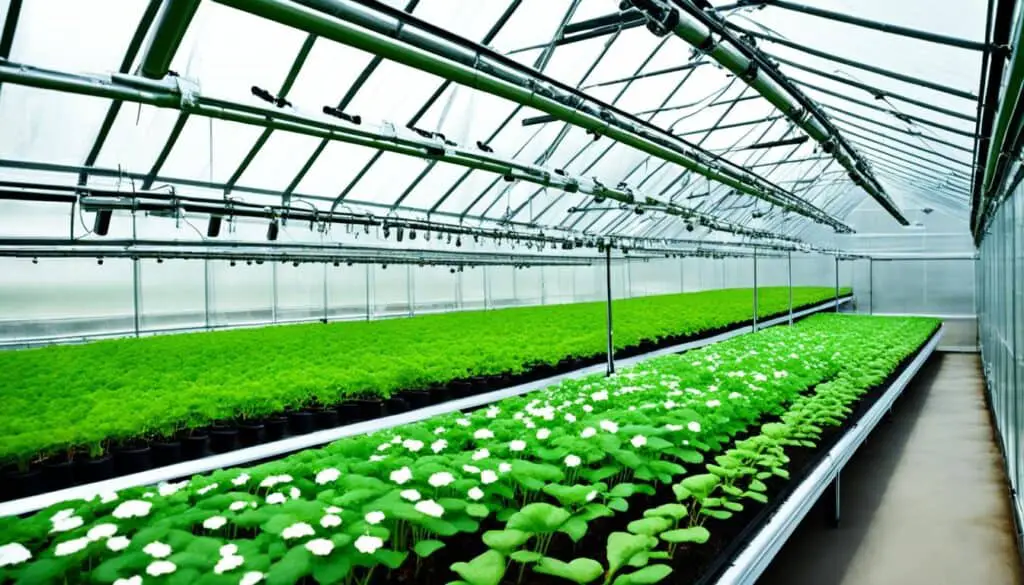
For those who require more control over airflow, the use of fans is recommended. Fans help circulate air throughout the greenhouse, preventing pockets of stagnant air and ensuring that all plants receive adequate ventilation. They can be strategically placed to target specific areas of the greenhouse or used in conjunction with other ventilation methods.
When designing your greenhouse ventilation system, it’s important to consider factors such as the size of your greenhouse, the number of plants, and the climate in your region. By providing proper ventilation, you can create a healthier and more productive greenhouse environment, enabling your plants to thrive and flourish.
Optimization of Natural and Artificial Light
In order to promote optimal plant growth in your greenhouse, it is essential to optimize the use of both natural and artificial light sources. This section will discuss techniques for maximizing natural light exposure and incorporating supplemental artificial lighting to provide plants with the ideal light spectrum for photosynthesis and growth.
When designing your greenhouse, it is crucial to consider the placement and orientation of windows, roof panels, and other transparent surfaces to allow ample natural light to enter the space. Natural light provides a full spectrum of wavelengths that plants need for various growth processes. Additionally, it is important to consider the impact of shadows cast by nearby structures or trees that may obstruct sunlight.
“Natural light provides a full spectrum of wavelengths that plants need for various growth processes.”
In situations where natural light is limited, supplemental artificial lighting can be used to provide plants with the necessary light energy. Artificial lighting systems come in various types, including fluorescent, LED, and high-intensity discharge (HID) lights. Each type of light has its own advantages and considerations, such as energy efficiency, light intensity, and spectral output.
When selecting artificial lighting for your greenhouse, consider the specific light requirements of your plants. Different plants have varying light intensity and spectral preferences. For example, leafy greens may thrive with lower light levels, while fruiting plants may require higher light intensities. It is important to match the light output of your artificial lighting system with the specific needs of your plants.
Furthermore, it is crucial to establish a proper lighting schedule to ensure plants receive consistent and balanced light exposure. This involves determining the ideal number of light hours per day and adjusting the lighting intensity during different growth stages. It is recommended to consult plant-specific lighting guidelines or seek advice from horticultural experts to optimize light levels for optimal growth.
In conclusion, optimizing natural and artificial light sources is essential for promoting healthy plant growth in your greenhouse. By maximizing natural light exposure and supplementing with artificial lighting when necessary, you can create an ideal environment for your plants to thrive.
Sustainable Flooring: Options Beyond Concrete
In a greenhouse, choosing the right flooring is crucial for creating a sustainable and functional environment. While concrete has been a popular choice, there are innovative alternatives available that offer improved efficiency and eco-friendliness. In this section, we will explore sustainable flooring options that go beyond traditional concrete, including heated sand floors and eco-friendly alternatives to conventional materials.
Heated Sand Floor Innovations
A heated sand floor is a unique flooring option that provides enhanced heat retention and energy efficiency in a greenhouse. This innovative solution involves installing a layer of sand beneath the greenhouse flooring, which is heated using radiant heating technology. The sand acts as a thermal mass, absorbing and storing heat, and gradually releasing it to maintain a consistent temperature in the greenhouse, even during colder periods.
The heated sand floor system is highly efficient, as it minimizes heat loss and reduces energy consumption compared to traditional heating methods. Additionally, it creates a comfortable environment for plants, promoting healthy growth without the need for excessive heating.
By utilizing heated sand floors in your greenhouse, you can optimize energy usage, lower heating costs, and provide a sustainable heating solution for year-round gardening.
Eco-friendly Alternatives to Traditional Flooring Materials
For those who prefer to explore eco-friendly options, there are several alternatives to traditional flooring materials that can be used in a greenhouse. These options provide sustainable and environmentally conscious choices:
- Bamboo flooring: Known for its renewable nature, bamboo is a durable and eco-friendly flooring material. It grows quickly, making it a highly sustainable choice.
- Cork flooring: Made from the bark of the cork oak tree, cork flooring is a renewable and biodegradable material. It is also naturally resistant to mold, mildew, and pests.
- Recycled rubber flooring: Made from recycled rubber tires, this flooring option is not only sustainable but also provides cushioning and insulation. It is highly durable and easy to maintain.
- Linoleum flooring: Made from renewable materials such as linseed oil, cork dust, and wood flour, linoleum flooring is an eco-friendly and biodegradable choice. It is also naturally antimicrobial.
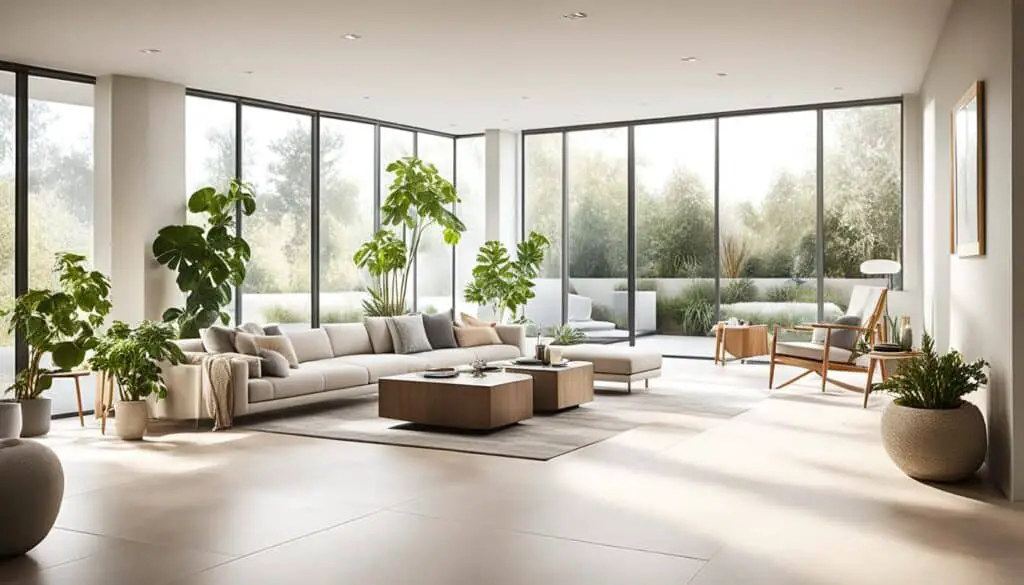
These eco-friendly flooring options offer excellent durability, sustainability, and aesthetic appeal for your greenhouse. By choosing these alternatives, you can create a more environmentally conscious space while ensuring long-lasting and functional flooring.
| Flooring Option | Benefits |
|---|---|
| Bamboo flooring | Rapidly renewable, durable, and sustainable |
| Cork flooring | Renewable, biodegradable, and naturally resistant to mold and pests |
| Recycled rubber flooring | Sustainable, cushioning, and easy to maintain |
| Linoleum flooring | Renewable, biodegradable, and naturally antimicrobial |
Maintaining Your Greenhouse: Tools and Tips
In order to ensure the long-term health and productivity of your greenhouse, regular maintenance is essential. By following some simple cleaning tips and using non-toxic cleaners, you can maintain a healthy greenhouse environment that promotes optimal plant growth. Let’s explore some tools and tips to help you in maintaining your greenhouse:
Importance of Regular Cleanings
Regular cleaning is crucial for greenhouse maintenance as it helps prevent the buildup of pests, diseases, and debris that can negatively affect your plants. Here are some key reasons why regular cleanings are important:
- Prevent the spread of plant diseases: Cleaning your greenhouse surfaces, such as the walls, floors, and benches, helps to remove any pathogens or spores that could lead to the spread of diseases.
- Remove pests and insects: Regular cleaning eliminates hiding places for pests and insects, reducing the risk of infestations. Cleaning also helps to remove pest eggs, larvae, or cocoons that may be present in your greenhouse.
- Ensure optimal light transmission: A clean greenhouse allows maximum light transmission, enabling your plants to thrive and photosynthesize effectively.
- Promote good air circulation: Removing clutter and debris from your greenhouse improves air circulation, preventing the buildup of stagnant air and reducing the risk of fungal diseases.
By incorporating regular cleaning into your greenhouse maintenance routine, you can create a clean and healthy environment for your plants to grow and flourish.
Choosing Non-toxic Cleaners for Your Greenhouse
When cleaning your greenhouse, it’s important to select non-toxic cleaners that won’t harm your plants, the environment, or your own health. Here are some tips for choosing non-toxic cleaners:
- Read product labels: Look for cleaners labeled as non-toxic, eco-friendly, or biodegradable. Avoid cleaners that contain harsh chemicals or toxins.
- Use natural cleaning solutions: Many non-toxic cleaners can be made at home using simple ingredients like vinegar, baking soda, and lemon juice. These natural solutions are effective for removing dirt, grime, and mildew.
- Consider steam cleaning: Steam cleaning is an environmentally friendly option that uses heat and moisture to clean and disinfect surfaces. It doesn’t require the use of chemicals and is effective for removing pests and pathogens.
- Test cleaners on a small area: Before using a new cleaner, test it on a small, inconspicuous area of your greenhouse to ensure it doesn’t harm your plants or cause any damage.
By choosing non-toxic cleaners, you can maintain a chemical-free greenhouse environment that promotes the health and well-being of your plants.
Cost-Effective Greenhouse Models for Home Gardeners
When it comes to greenhouse gardening, cost-effectiveness is an important consideration for many home gardeners. Fortunately, there are affordable greenhouse models available that offer both functionality and practicality without breaking the bank. In this section, we will explore two budget-friendly options: lean-to and eve-span greenhouses. We will also discuss the benefits of free-standing conversion kits to maximize efficiency and affordability.
Lean-To and Eve-Span Greenhouses on a Budget
Lean-to greenhouses are a popular choice for gardeners with limited space or those who want to utilize an existing wall or structure for added support. By attaching the greenhouse to an existing building, you can save on construction costs while still enjoying the benefits of a controlled environment for your plants. Lean-to greenhouses are particularly cost-effective because they require fewer materials and have a smaller footprint.
Eve-span greenhouses, on the other hand, are designed to span the entire length of a building, such as a garage or shed. These greenhouse models provide ample growing space and harness the existing structure’s thermal mass to help regulate temperature and reduce heating costs. With eve-span greenhouses, you can create a seamless extension of your home or outdoor building without the need for additional foundations or structures.
Both lean-to and eve-span greenhouses offer a cost-effective solution for home gardeners who want to enjoy the benefits of greenhouse gardening while maximizing their budget. These models are versatile, practical, and can be customized to suit your specific gardening needs.
Maximize Efficiency with Free-Standing Conversion Kits
If you already have a structure that can be converted into a greenhouse, consider using a free-standing conversion kit. These kits typically include a set of frames, panels, and other necessary components to transform an existing structure into a functional greenhouse. Free-standing conversion kits are cost-effective because they eliminate the need for extensive construction or dedicated greenhouse structures.
With a free-standing conversion kit, you can turn a patio, deck, or even a storage shed into a greenhouse, providing an enclosed growing space for your plants. These kits often come with easy-to-follow instructions, making it a DIY-friendly option for home gardeners. By repurposing an existing structure, you can save on construction costs and still enjoy the benefits of a greenhouse environment.
By opting for lean-to and eve-span greenhouses or free-standing conversion kits, you can create a cost-effective greenhouse that meets your gardening needs without sacrificing quality or functionality.
Conclusion
Throughout this article, we have explored the world of sustainable greenhouse plans and the benefits they offer to gardeners like you. By embracing eco-friendly greenhouse design and incorporating sustainable gardening practices, you can create an environmentally friendly and productive greenhouse space.
From considering the location and size of your greenhouse to selecting the right materials and optimizing lighting and temperature, every aspect of greenhouse design plays a crucial role in creating a sustainable and efficient growing environment. By utilizing techniques like rainwater harvesting, smart irrigation systems, and energy-efficient heating options, you can reduce your reliance on external resources and minimize your environmental impact.
Remember, sustainable gardening is not only beneficial for the planet but also for your plants. By providing a healthy and balanced environment, you can ensure optimal plant growth and productivity. So, whether you are a seasoned gardener or just starting out, we encourage you to implement these strategies and make a positive contribution to the planet through your greenhouse endeavors.
FAQ
What are sustainable greenhouse plans?
Sustainable greenhouse plans are designs and strategies that incorporate eco-friendly practices and materials to create an environmentally conscious growing space. These plans aim to extend the growing season, reduce reliance on external resources, and minimize the ecological footprint of greenhouse gardening.
How can sustainable greenhouses benefit gardeners?
Sustainable greenhouses offer a range of benefits for gardeners. They provide an extended growing season, allowing for year-round gardening and the cultivation of a wider variety of plants. Additionally, sustainable greenhouses offer protection from extreme weather conditions, such as frost, hail, and storms. They also reduce reliance on external resources, including water and energy, making gardening more cost-effective and environmentally friendly.
What are the key considerations for designing an eco-friendly greenhouse?
When designing an eco-friendly greenhouse, several considerations are essential. These include selecting a suitable location that maximizes sunlight exposure while protecting the greenhouse from harsh weather conditions. Additionally, proper ventilation and energy-efficient design features, such as insulation and glazing, need to be incorporated into the greenhouse plans to ensure optimal sustainability.
How do I choose the right size and location for a sustainable greenhouse?
Choosing the right size and location for a sustainable greenhouse depends on several factors. Consider the available space in your yard or garden and ensure the greenhouse receives adequate sunlight throughout the day. Additionally, select a location that offers protection from strong winds and extreme temperatures. A suitable size will depend on your gardening needs and available space.
What are some eco-conscious structural materials for greenhouse construction?
There are several eco-conscious materials available for greenhouse construction. Some examples include recycled materials, FSC-certified wood, and energy-efficient glazing. These materials not only reduce environmental impact but also contribute to the energy efficiency of the greenhouse.
What are some innovative DIY greenhouse plans and ideas?
There are many creative DIY greenhouse plans and ideas available. One example is building a greenhouse using upcycled materials, such as old windows or doors. Another option is constructing a geodesic dome greenhouse, which provides an efficient and aesthetically unique growing environment. Custom greenhouse building can also be tailored to suit individual preferences and specific gardening needs.
What are some insulation techniques for maintaining year-round warmth in the greenhouse?
There are various insulation techniques that can help keep a greenhouse warm throughout the year. Among these techniques are using eco-friendly insulation materials such as double-glazed windows, polycarbonate panels, or bubble wrap. Additionally, employing low-cost insulation hacks like insulating the foundation or using thermal curtains can improve energy efficiency and temperature regulation in the greenhouse.
How can I balance the temperature sustainably in my greenhouse?
Balancing the temperature sustainably in a greenhouse can be achieved through various methods. Some energy-efficient heating options include solar heating, biomass heating, or utilizing heat retention techniques such as thermal mass walls. These strategies help reduce reliance on traditional heating sources and minimize energy consumption.
What are some advanced glazing options for improving efficiency and durability in the greenhouse?
There are several advanced glazing options that can enhance efficiency and durability in a greenhouse. Some of these options include polycarbonate panels, multi-wall glazing, or UV-blocking films. Understanding the concept of R-values is also important when selecting glazing materials, as they influence insulation properties and energy efficiency.
How can I manage water sustainably in my greenhouse?
Smart water management in a greenhouse can be achieved through various techniques. Implementing drip irrigation systems is an efficient way to distribute water precisely to plants, minimizing waste. Additionally, harvesting rainwater can significantly reduce dependence on the mains water supply, making the greenhouse more environmentally friendly.
What are the essential ventilation considerations for a greenhouse?
Proper ventilation is crucial for maintaining a healthy growing environment in a greenhouse. Natural ventilation, such as ridge vents and louvers, allows for air circulation and temperature regulation. Fans can also be used when additional airflow is required. These ventilation options help prevent plant diseases and ensure optimal plant growth.
How can I optimize natural and artificial light in my greenhouse?
To optimize natural light in a greenhouse, choose a location with maximum sunlight exposure and position plants accordingly. Supplemental artificial lighting can also be used to provide the necessary light spectrum for photosynthesis and growth. LED grow lights are popular options due to their energy efficiency and adjustable light intensity.
What are some sustainable flooring options for a greenhouse?
Beyond traditional concrete flooring, there are several sustainable flooring options for a greenhouse. One innovative solution is heated sand floors, which provide improved heat retention and energy efficiency. Other eco-friendly alternatives include using recycled rubber flooring or natural materials like gravel or wood chips.
How do I maintain my greenhouse?
Regular maintenance is crucial to keep a greenhouse healthy and productive. It is important to clean the greenhouse regularly to prevent pests and diseases. Non-toxic cleaners should be used to maintain a chemical-free environment. Additionally, regularly inspecting equipment, such as fans or irrigation systems, ensures they are functioning properly.
What are some cost-effective greenhouse models for home gardeners?
Lean-to and eve-span greenhouses are cost-effective options for home gardeners. These models utilize existing structures, such as a wall or the side of a building, which reduces the materials and labor required. Another option is using free-standing conversion kits, which allow for easy installation and maximize efficiency while remaining affordable.


